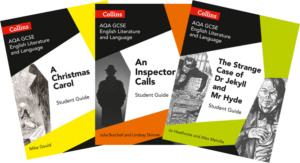Starting a new text with your class is always a joy, reading collectively and hearing their opinions and reflections never fails to brighten my day. But how do you teach the text in a way that is creative and animated whilst also letting the crucial exam requirements take centre stage?
Firstly, Collins’ ‘An Inspector Calls’ Student Guide is incredibly user friendly and guides your students thoroughly through the play, building skills and knowledge along the way. Alongside the play it gives plenty of opportunity to analyse English Language non-fiction texts which add context to the play and will harbour a more informed response.
Having taught GCSE English for over 10 years to at least 3 GCSE classes a year of all abilities I feel that ultimately success lies with students having a clear understanding and ownership of what they need to do for their target grades. Clarity is of vital importance and it is worth beginning the topic with the requirements for A01, A02 and A03 broken down into language that students can understand and apply to the text. As well as the A0 descriptors it is beneficial to teach according: AO1 WHAT, A02 WHY and A03 HOW – indeed have these reminders above the board. It is also a good idea to colour code these and have students use either highlighters or a different coloured pen for each so that there is visual clarification for the balance needed in their responses (A01 – 12 marks, A02+A03 6 marks).
With any GCSE text I always begin a character mapping system in the first few lessons which is continued without fail throughout the terms and as a homework task. Firstly, ask students who they think are the key characters of the play. Can they justify their answers? On their first reading which characters are the most important? Could they put them into order? Later on in the term you can repeat this exercise, have their opinions changed? Why?
On A3 paper or in exercise books ask students to draw the key characters according to evidence from the text. Apply (A01) by asking them to write WHAT ideas they have about the character. Alternatively you could hand out images from the film of the central characters as an introductory task.
Can they now add quotes about the character? This should be added to lesson by lesson and as homework during the term. Ask students to pay particular interest to the character’s likes, dislikes, behaviour, stage directions and language choices. Apply (A02) by asking students to explain HOW Priestly makes the reader or audience feel towards them. For example they could look at this quote by Mr Birling, ‘You’ll hear that some people think that war’s inevitable. And to that I say – fiddlesticks! The Germans don’t want war…Nobody wants war’ by using dramatic irony, Priestly creates a character that is confident and self-assured but that the audience knows is misinformed and pompous (A02). The short, direct imperative shows that he thinks his opinions are the most important and that as the head of the family, he can bark out his opinions for all to admire and believe (A01) For (A03) could students suggest reasons why he feels he needs this authority and to be admired as an educated man?
What about the characters responses and relationships to other characters? HOW (AO2) does Priestly make us feel towards them? Start to collect evidence that can then be used seamlessly in exam responses. Next to these responses can students now apply (A03) by suggestions reasons as to WHY this character has been presented to the audience in such a way?
Can they now add context from their knowledge of non-fiction texts or the history of the time? For example, the play is set in Brumley in 1900s which was a very working class area yet Priestly’s stage directions describe our setting as a ‘fairly large suburban house belonging to a prosperous manufacturer’, can they identify key words here such as ‘prosperous’ and use point, evidence, explanation to expand on the choice of language? (A03)
Finally I like students to identify key moments in each characters developments or to the development of the play as a whole, collecting quotes and analysing HOW (A02) these events shape the play, WHY (A03) these events are important and WHAT (A01) they show the audience. Another lovely exercise is to collect the classes work and compile it to a revision booklet or scan it and share it as public file.
By constantly adding to these character maps students are building their knowledge, using their creative flair, applying the A0s in a way that becomes second nature and importantly, beginning to read for purpose and meaning. These skills are crucial for further education and prepare your students academically for what may lie ahead.
By Joanna Fliski
Joanna Fliski has taught English Literature and Language to 11-18 year olds at an urban comprehensive secondary school for 10 years, she had the highest value added score for her students and was nominated for an outstanding teacher award. As well as teaching Drama and Media GCSE she was head of PSHE, trained teachers and is a behavioural specialist. Joanna currently teaches in primary schools in Bristol. She is also a freelance author, writing resources and teacher guides for the Cambridge IGCSE, creating schemes of work and contributing to a number of educational blogs.
Collins’ An Inspector Calls Set Text Student Guide has been designed to improve skills in both English Language and Literature whilst strengthening understanding of the play’s themes and contexts. Complete with plot and character summaries, end of chapter tasks, and sample responses, the Guide helps prepare students for exam success.
Also available in this series are Guides for A Christmas Carol and The Strange Case of Dr. Jekyll and Mr. Hyde.




